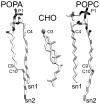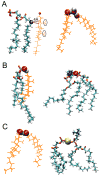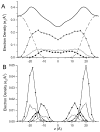Molecular dynamics simulations of ternary membrane mixture: phosphatidylcholine, phosphatidic acid, and cholesterol
- PMID: 18052271
- PMCID: PMC3286516
- DOI: 10.1021/jp075467b
Molecular dynamics simulations of ternary membrane mixture: phosphatidylcholine, phosphatidic acid, and cholesterol
Abstract
A ternary mixture of 1-palmitoyl-2-oleoyl phosphatidylcholine (POPC), 1-palmitoyl-2-oleoyl phosphatidic acid (POPA), and cholesterol (CHOL) works effectively for a functional conformation of nicotinic acetylcholine receptor (nAChR) that can undergo agonist-induced conformation changes, but POPC alone can stabilize only a desensitized state of nAChR. To gain insights into the lipid mixture that has strong impact to nAChR functions, we performed more than 50 ns all atom molecular dynamic (MD) simulations at 303 K on a fully hydrated bilayer consisting of 240 POPC, 80 POPA, and 80 CHOL (3:1:1). The MD simulation revealed various interactions between different types of molecular pairs that ultimately regulated lipid organization. The heterogeneous interactions among three different constituents resulted in a broad spectrum of lipid properties, including extensive distributions of average area per lipid and varied lipid ordering as a function of lipid closeness to CHOL. Higher percentage of POPA than POPC had close association with CHOL, which coincided with relatively higher ordering of POPA molecules in their acyl chains near lipid head groups. Lower fraction of gauche dihedrals was also found in the same region of POPA. Although the CHOL molecules had the effects on the enhancement of surrounding lipid order, relatively low lipid order parameters and high fraction of gauche bonds were observed in the ternary mixture. Collectively, these results suggest that the dynamical structure of the ternary system could be determinant for a functional nAChR.
Figures







Similar articles
-
Anionic lipid and cholesterol interactions with alpha4beta2 nAChR: insights from MD simulations.J Phys Chem B. 2009 May 14;113(19):6964-70. doi: 10.1021/jp900714b. J Phys Chem B. 2009. PMID: 19419220 Free PMC article.
-
Insight into the putative specific interactions between cholesterol, sphingomyelin, and palmitoyl-oleoyl phosphatidylcholine.Biophys J. 2007 Feb 15;92(4):1125-37. doi: 10.1529/biophysj.106.088427. Epub 2006 Nov 17. Biophys J. 2007. PMID: 17114220 Free PMC article.
-
Cholesterol effects on a mixed-chain phosphatidylcholine bilayer: a molecular dynamics simulation study.Biochimie. 2006 May;88(5):449-60. doi: 10.1016/j.biochi.2005.10.005. Epub 2005 Nov 7. Biochimie. 2006. PMID: 16356621
-
Behavioral differences between phosphatidic acid and phosphatidylcholine in the presence of the nicotinic acetylcholine receptor.Biophys J. 2008 Dec 15;95(12):5637-47. doi: 10.1529/biophysj.108.136895. Epub 2008 Oct 3. Biophys J. 2008. PMID: 18835908 Free PMC article.
-
Lipid composition alters drug action at the nicotinic acetylcholine receptor.Mol Pharmacol. 2008 Mar;73(3):880-90. doi: 10.1124/mol.107.039008. Epub 2007 Nov 30. Mol Pharmacol. 2008. PMID: 18055762
Cited by
-
Examining the contributions of lipid shape and headgroup charge on bilayer behavior.Biophys J. 2008 Sep 15;95(6):2636-46. doi: 10.1529/biophysj.107.128074. Epub 2008 May 30. Biophys J. 2008. PMID: 18515396 Free PMC article.
-
Anionic lipid and cholesterol interactions with alpha4beta2 nAChR: insights from MD simulations.J Phys Chem B. 2009 May 14;113(19):6964-70. doi: 10.1021/jp900714b. J Phys Chem B. 2009. PMID: 19419220 Free PMC article.
-
Lipid-modulation of membrane insertion and refolding of the apoptotic inhibitor Bcl-xL.Biochim Biophys Acta Proteins Proteom. 2019 Jul-Aug;1867(7-8):691-700. doi: 10.1016/j.bbapap.2019.04.006. Epub 2019 Apr 18. Biochim Biophys Acta Proteins Proteom. 2019. PMID: 31004798 Free PMC article.
-
Binding of β-amyloid (1-42) peptide to negatively charged phospholipid membranes in the liquid-ordered state: modeling and experimental studies.Biophys J. 2012 Aug 8;103(3):453-463. doi: 10.1016/j.bpj.2012.06.043. Biophys J. 2012. PMID: 22947861 Free PMC article.
-
In silico models for the human alpha4beta2 nicotinic acetylcholine receptor.J Phys Chem B. 2008 Nov 6;112(44):13981-90. doi: 10.1021/jp804868s. Epub 2008 Oct 11. J Phys Chem B. 2008. PMID: 18847252 Free PMC article.
References
-
- Lee AG. Biochim Biophys Acta. 2003;1612:1. - PubMed
-
- Barrantes FJ. Brain Res Brain Res Rev. 2004;47:71. - PubMed
-
- Miyazawa A, Fujiyoshi Y, Unwin N. Nature. 2003;423:949. - PubMed
-
- Unwin N. J Mol Biol. 2005;346:967. - PubMed
-
- Baenziger JE, Morris ML, Darsaut TE, Ryan SE. J Biol Chem. 2000;275:777. - PubMed
Publication types
MeSH terms
Substances
Grants and funding
LinkOut - more resources
Full Text Sources
Medical
Miscellaneous

